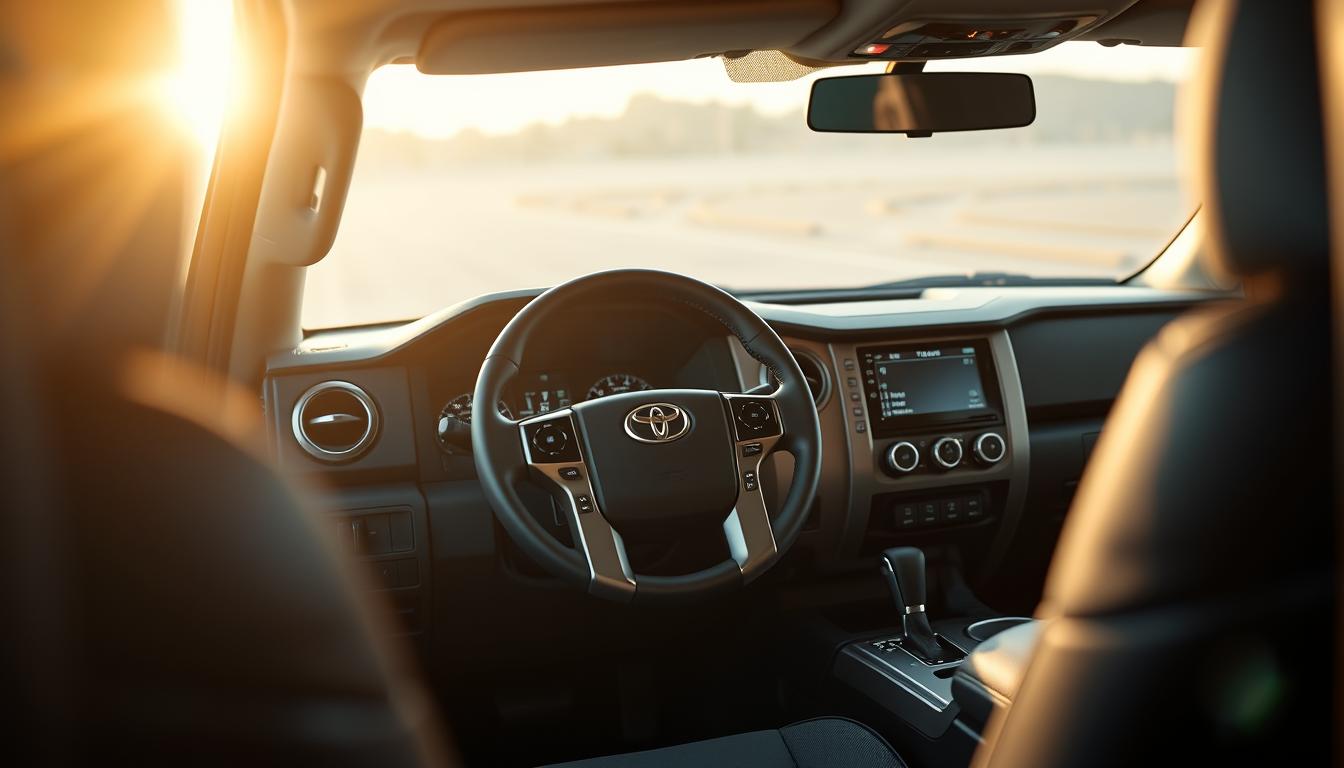To keep your Toyota Tundra at its safest, focusing on its safety rating is essential. This detailed guide will discuss various methods to improve your vehicle’s safety rating. By upgrading safety components and using cutting-edge technology, driving becomes safer and more reassuring.
We will explore practical measures to boost the safety of your Toyota Tundra. Our goal is to make every journey as secure as it can be.
Understanding the Toyota Tundra Crash Test Rating
The Toyota Tundra has been rigorously tested to ensure it meets vehicle safety standards. This is to confirm it’s reliable in various crash situations. The Toyota Tundra crash test rating shows how well it can shield its occupants in a crash. These tests measure impact resistance, structure strength, and how effective its safety features are.
Entities like the National Highway Traffic Safety Administration (NHTSA) and the Insurance Institute for Highway Safety (IIHS) conduct these crash tests. They use their distinct vehicle safety standards to gauge the Toyota Tundra’s overall safety. The tests replicate front, side, and rollover accidents to reflect real-life crash conditions.
The NHTSA uses star ratings to show the Toyota Tundra’s performance in these evaluations. More stars mean better protection for those inside. In the same vein, the IIHS ranks from “Poor” to “Good,” shedding light on crash avoidance and survivability. By looking at the Toyota Tundra’s crash test ratings, buyers gain valuable insight into its safety features.
Importance of Regular Vehicle Maintenance for Safety
Regular maintenance is crucial for your Toyota Tundra’s longevity and safety. Maintaining tires, brakes, and fluid levels is vital for safe driving.
Ensuring Proper Tire Condition
For a Toyota Tundra, maintaining tire condition is critical. Regular checks on tire pressure, treads, and alignment boost safety and performance. Good tires improve grip, lowering accident risks.
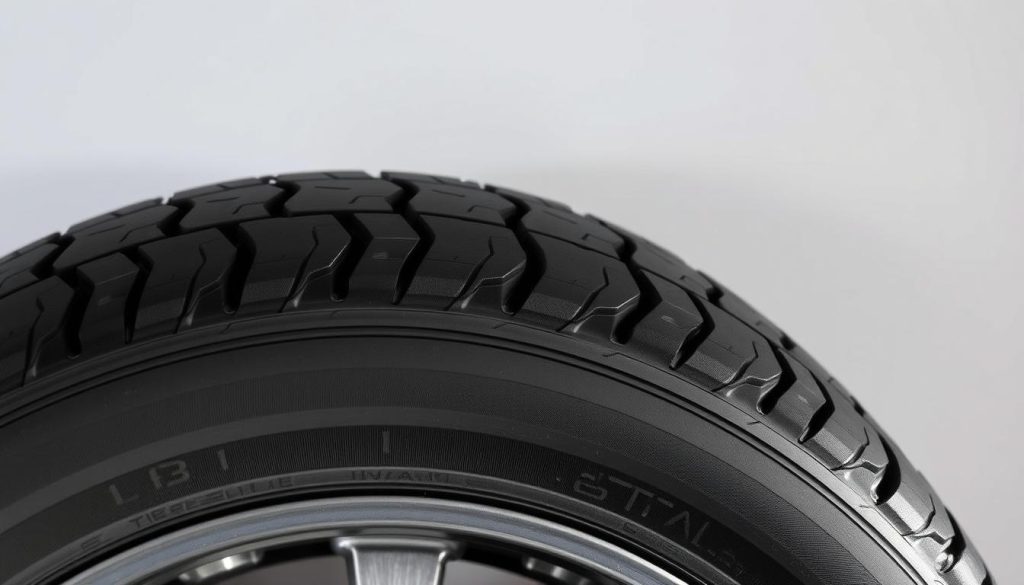
Routine Brake Checks
Brakes are essential for the Toyota Tundra’s safety. Routine checks ensure efficient brake response. These inspections detect worn pads and fluid leaks, maintaining performance.
Fluid Level Management
Maintaining fluid levels is key to your vehicle’s maintenance. Engine oil, transmission fluid, brake fluid, and coolant affect your Tundra’s performance and safety. Regular checks and replacements prevent failures and enhance operation.
Key Toyota Tundra Safety Features
The Toyota Tundra stands out for its extensive safety features, safeguarding drivers and pedestrians alike. These innovations enhance performance while ensuring peace of mind during travel.
Pre-Collision System with Pedestrian Detection
This system vigilantly scans the road for potential hazards using cutting-edge sensors. It alerts the driver about possible collisions, whether with other vehicles or pedestrians. Should the driver fail to react, it initiates automatic braking to reduce or prevent impact.
Dynamic Radar Cruise Control
Dynamic Radar Cruise Control plays a key role in the Tundra’s safety suite. It automatically adjusts speed to maintain a safe distance from the car ahead. This feature not only minimizes driver strain but also enhances comfort on long journeys.
Lane Departure Alert with Steering Assist
The Lane Departure Alert with Steering Assist feature helps keep the vehicle properly aligned within its lane. It detects lane markers and warns if the car begins to veer off course. Steering assistance then helps correct the vehicle’s path, promoting safer driving.
Advancements in Toyota Tundra Safety Technology
The Toyota Tundra continues to elevate safety in the automotive world. It’s packed with advanced driving assistance systems that boost driver awareness and road safety.
Automatic High Beams
A camera-driven technology, Automatic High Beams adjust between high and low beams when oncoming vehicles are detected. This maintains optimal visibility at night without impairing the vision of other drivers, enhancing safety.
Road Sign Assist
Road Sign Assist employs a smart camera to recognize and interpret road signs, such as speed limits and stop signs. It displays this critical information on the dashboard, ensuring the driver stays informed and attentive.
Blind Spot Monitor
The Blind Spot Monitor senses vehicles in the adjacent lanes that might escape the driver’s view. This technology boosts situational awareness, making lane changes safer by reducing collision risks.
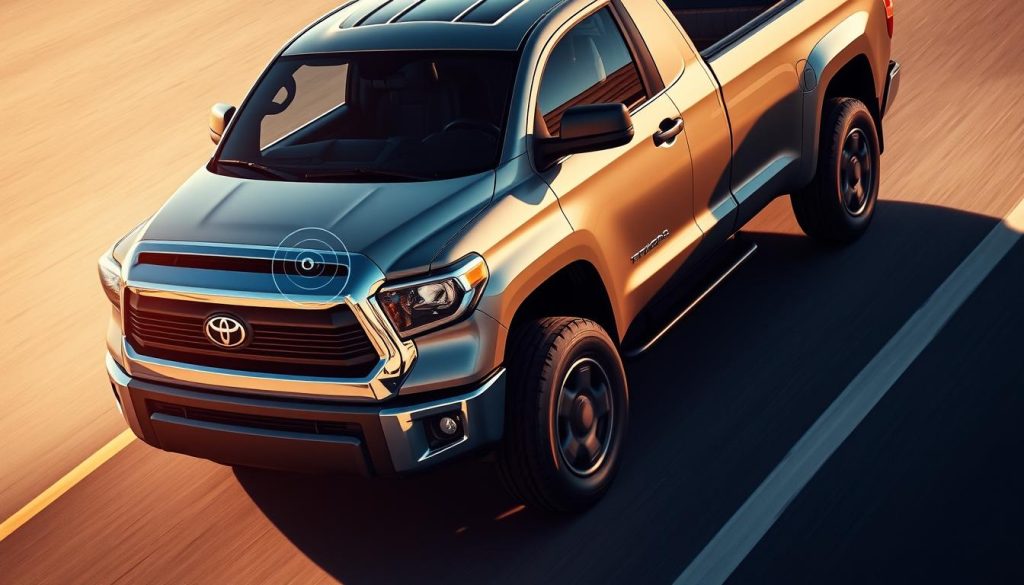
The 2022 Toyota Tundra Crew Cab and Extended Cab models have been honored with the Top Safety Pick awards from the Insurance Institute for Highway Safety. This achievement comes from excelling in rigorous safety tests, including frontal and side impact evaluations, which underscores Toyota’s dedication to safety.
Toyota’s commitment to advancing safety technologies helps the Tundra stay ahead in the industry. These features mark the brand’s ongoing mission to offer vehicles that not only meet but surpass safety expectations.
How to Interpret the Toyota Tundra IIHS Safety Rating
For those considering the Toyota Tundra, understanding its IIHS safety rating is crucial. The Insurance Institute for Highway Safety (IIHS) ratings, while comprehensive, can be complex. We’ll simplify how to interpret these ratings and their significance in choosing a vehicle.
The IIHS evaluates vehicles through various crash tests, including frontal and side crashes, and roof strength tests. These tests assess how well the vehicle protects its passengers during accidents. A strong performance here indicates excellent safety and occupant protection.
The IIHS employs a rating scale from “Good” to “Poor”. A “Good” rating means outstanding performance, while “Poor” indicates the need for improvement. For the Toyota Tundra, a “Good” rating across many categories signals high safety standards. Thus, understanding these ratings is key to making knowledgeable choices.
Moreover, the IIHS assesses headlights and crash prevention systems. Proper headlight performance is crucial for night driving, while advanced crash prevention reduces accident risks. The Toyota Tundra’s strong scores in these areas showcase its dedication to all-around safety.
The table below provides a summary of the Toyota Tundra IIHS safety rating compared to another popular truck:
| Safety Categories | Toyota Tundra | Competitor Truck |
|---|---|---|
| Frontal Crash Test | Good | Acceptable |
| Side Crash Test | Good | Marginal |
| Roof Strength | Good | Good |
| Headlight Performance | Acceptable | Marginal |
| Crash Prevention Systems | Superior | Advanced |
A thorough understanding of the Toyota Tundra IIHS safety ratings empowers you to make well-informed decisions. Recognizing and interpreting these scores helps appreciate the Tundra’s safety features, enhancing confidence in its protection levels.
Trends in Toyota Tundra Safety Ratings and Reviews
In the realm of automobiles, the vehicle safety trends for the Toyota Tundra have improved significantly. By examining recent Toyota Tundra safety ratings and reviews, notable strides in safety perception and metrics become clear. This insight offers a fuller understanding of the truck’s steadfast reliability and safety stature.
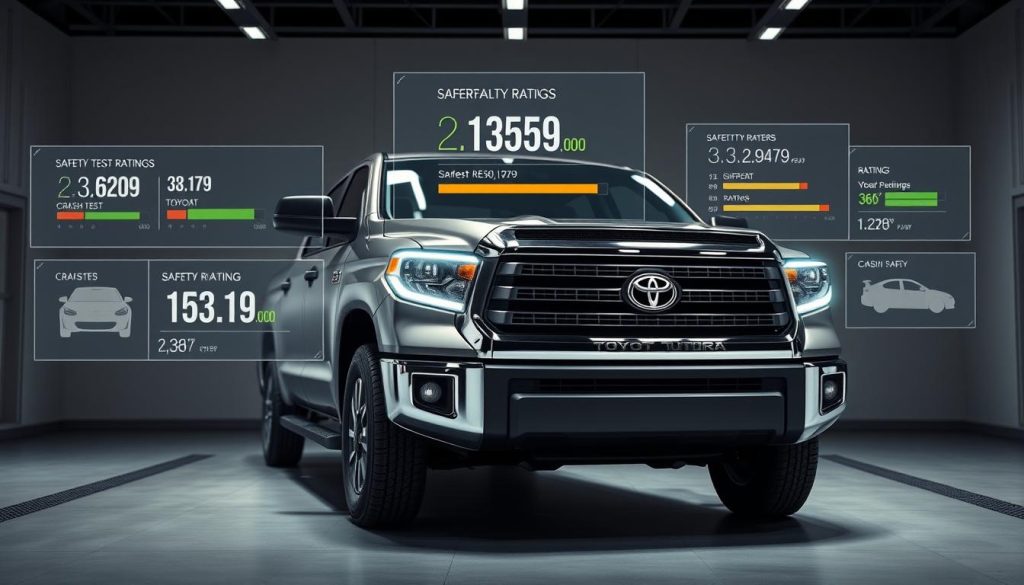
The Toyota Tundra’s safety ratings have consistently risen, showcasing strides in design and technological innovation. Factors like crash test outcomes, user feedback, and safety feature advancements are crucial. Here’s a brief overview of these aspects in recent times:
| Year | Crash Test Ratings (Out of 5) | Consumer Reviews (Out of 5) | Key Safety Features |
|---|---|---|---|
| 2021 | 4.5 | 4.2 | Pre-Collision System, Lane Departure Alert |
| 2020 | 4.3 | 4.1 | Dynamic Radar Cruise Control, Automatic High Beams |
| 2019 | 4.0 | 4.0 | Blind Spot Monitor, Rear Cross Traffic Alert |
These emerging vehicle safety trends showcase a dedication to enhancing the Toyota Tundra’s safety standards. The positive reviews echo growing user trust, which propels further advancements in safety technologies. Keeping pace with these trends allows potential buyers to make educated decisions on their vehicle investments.
Enhancing Your Toyota Tundra NHTSA Safety Rating
To boost your Toyota Tundra NHTSA safety rating, you have several strategies at your disposal. First and foremost, consider the latest safety upgrades available. These include sensor-based technologies like blind-spot monitoring and rear cross-traffic alerts. Such features add an extra security layer for your vehicle.
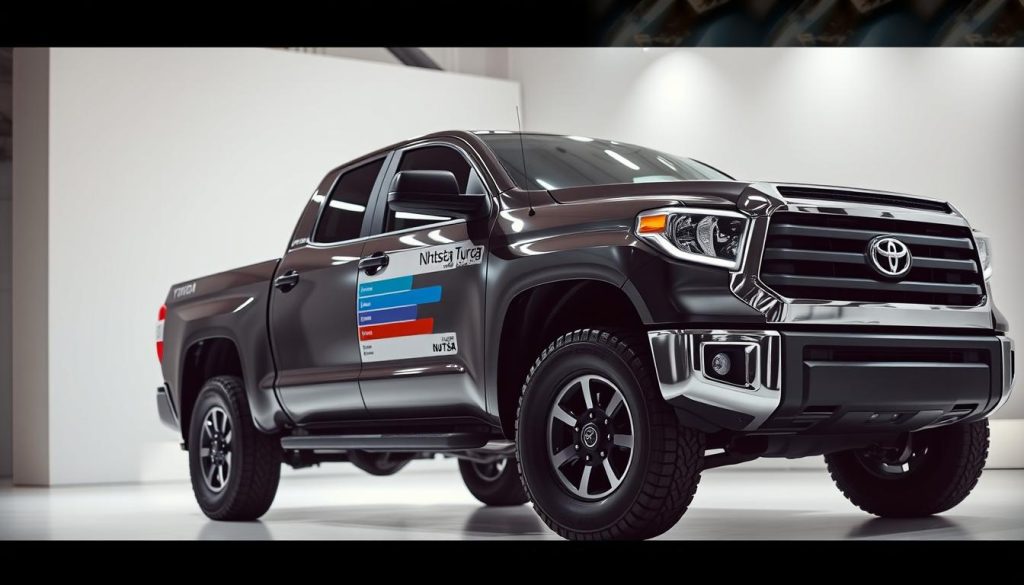
Another beneficial action is investing in premium tires and keeping them properly inflated. This greatly enhances your vehicle’s handling, which is crucial for safety. Additionally, focusing on advanced braking systems plays a significant role. By incorporating adaptive braking technologies, you can significantly reduce stopping distances, elevating your safety score.
Here’s a brief comparison of safety features that could uplift the Toyota Tundra NHTSA safety rating:
| Safety Feature | Benefits |
|---|---|
| Blind Spot Monitoring | Detects vehicles in blind spots, preventing collisions |
| Rear Cross-Traffic Alert | Warns of approaching traffic when reversing |
| Adaptive Braking Systems | Reduces stopping distances in emergencies |
| High-Quality Tires | Improves traction and handling |
Don’t overlook the importance of regular maintenance. Making sure every system in your vehicle works optimally not just boosts performance; it also enhances your Toyota Tundra NHTSA safety rating. Lastly, staying informed about recalls and safety notices from the manufacturer ensures your vehicle remains in excellent condition.
Toyota Tundra Safety Ratings 2021: What Has Changed?
The Toyota Tundra safety ratings 2021 have shown significant safety improvements from past versions. New to this model are the knee airbags for driver and front passenger. Before this, such airbags weren’t included. Furthermore, side curtain airbags now extend further and have updated deployment for certain crashes, enhancing protection for those inside.
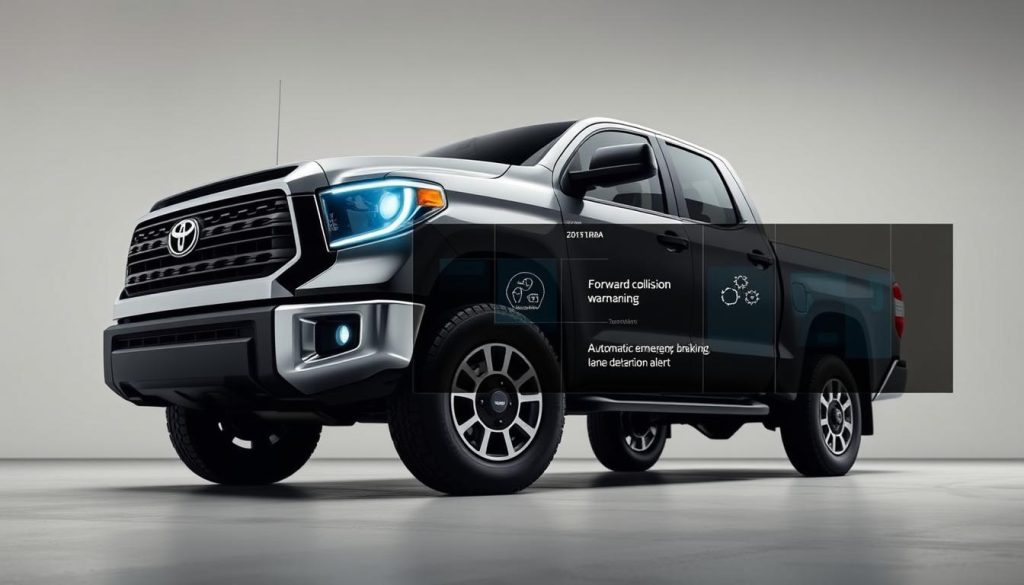
In terms of structural integrity, the Toyota Tundra received high marks. Its frame and safety cage improved, moving from ‘Acceptable’ to ‘Good’ in one key test. This shows a greater ability to withstand crashes. Although some injury measures need further work, the progress made in other areas reflects ongoing commitment to safety.
The moderate overlap front test continues to show excellent results, with most injury categories rated as ‘Good’. The Tundra’s front crash prevention system, featuring a Pre-Collision System with Pedestrian Detection, earns a ‘Superior’ mark. This highlights its success in avoiding crashes.
The 2021 Tundra has also strengthened its roof, resisting up to 23,069 lbs of force. Its strength-to-weight ratio of 4.49 points to its durability and safety focus. These advancements signal a strong commitment to improving the safety standards of the Tundra.
Improvements in child seat anchor ratings to ‘Marginal’ for models from 2016 to 2021 showcase enhanced safety for the youngest passengers. While there’s still room for enhancement, these updates promise better safety for families. The overall modifications in the 2021 Tundra reflect a comprehensive approach to vehicle safety.
Proactive Safety Measures for Toyota Tundra Owners
For Toyota Tundra owners, adopting proactive safety strategies is essential. Maintaining a safe following distance is key. This practice gives enough time to respond to unexpected changes in traffic. It significantly lowers the chance of rear-end collisions.
Moreover, adding safety equipment like dash cams and tire pressure monitors boosts vehicle safety. Owners should regularly check their vehicle’s tires, brakes, and fluid levels. This ensures everything is optimal, reducing the likelihood of accidents.
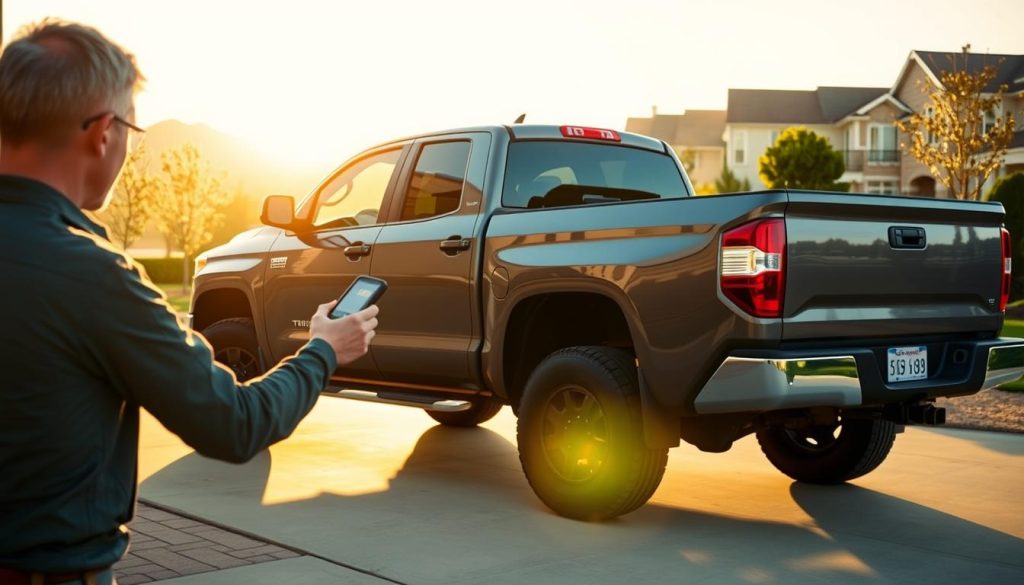
Practicing proactive safety strategies, such as regular safety drills, is helpful. These drills should include emergency braking and evasive maneuvers, conducted in a safe area. Remaining vigilant and up-to-date with safety technology aids in risk reduction. This enhances the overall safety of driving experiences.
Using modern driver-assistance technology adds an extra layer of security. Systems like adaptive cruise control and lane departure alerts help keep driving safe. Keeping your vehicle’s safety systems updated is essential for their effectiveness.
Lastly, deeply understanding traffic laws and committing to continuous driver education is crucial. This ensures Toyota Tundra owners are ready for any driving situation. It contributes to making the roads safer for everyone.
Comparing Toyota Tundra Safety Ratings to Competitors
When looking at the Toyota Tundra safety rating, comparing it to its main rivals is key. Such a competitor comparison gives insights for those seeking the safest vehicle.
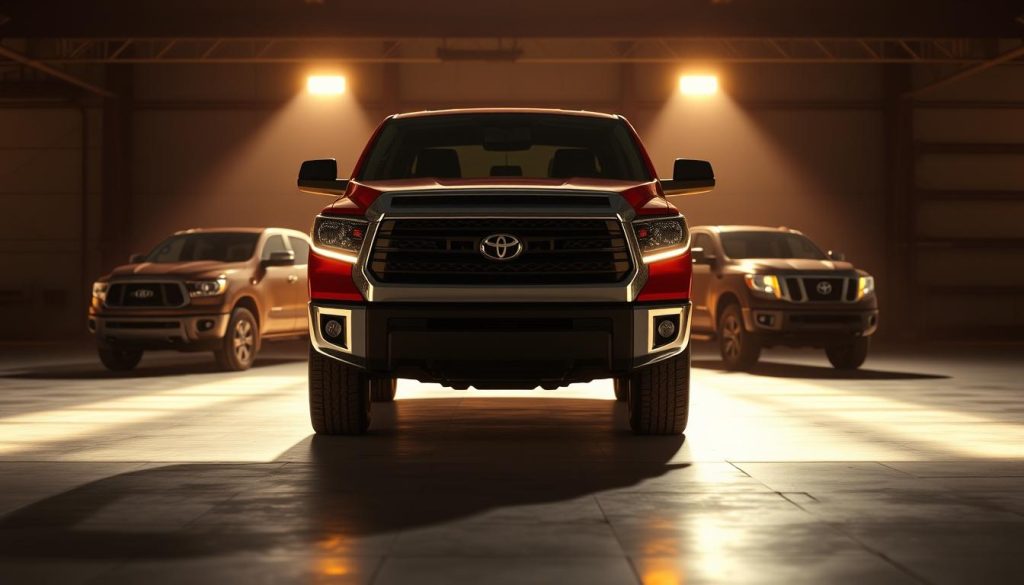
In a detailed comparison with top trucks, we focus on safety ratings. The aim is to understand how Toyota Tundra stands in terms of safety.
| Model | IIHS Safety Rating | NHTSA Safety Rating | Notable Safety Features |
|---|---|---|---|
| Toyota Tundra | Good | 5 Stars | Pre-Collision System, Lane Departure Alert |
| Ford F-150 | Good | 5 Stars | Autonomous Emergency Braking, Blind Spot Monitor |
| Chevrolet Silverado | Good | 4 Stars | Forward Collision Alert, Lane Keep Assist |
| Ram 1500 | Good | 5 Stars | Adaptive Cruise Control, ParkSense |
Toyota Tundra’s safety rating is competitive, showing strong features for safety. This deep competitor comparison helps buyers make decisions focused on safety.
Tips for Upgrading Toyota Tundra Safety Features
Enhancing your Toyota Tundra with advanced safety features can significantly improve how you experience driving. Focus on these impactful tips to upgrade and enhance your vehicle’s safety efficiently.
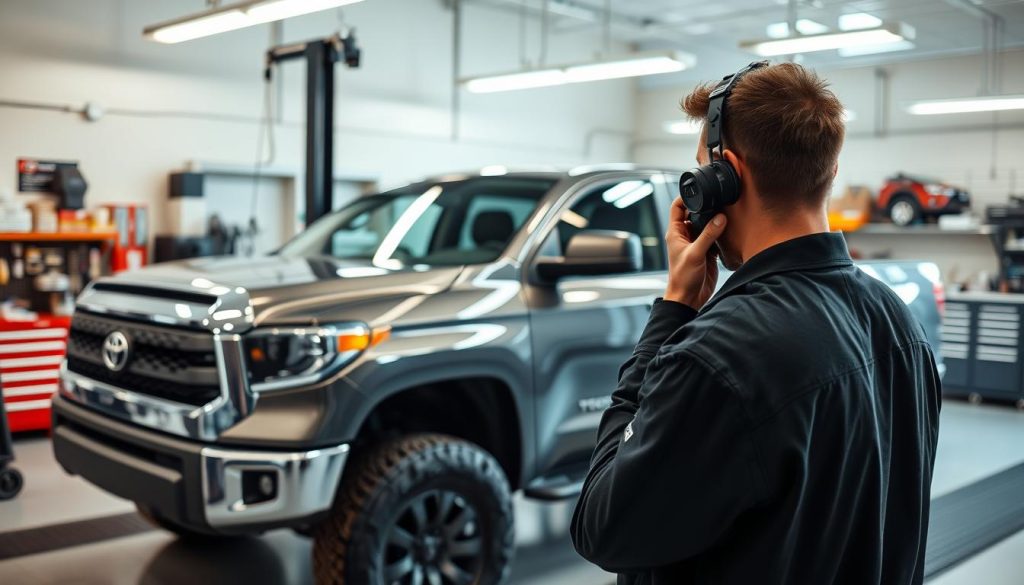
Advanced Driver Assistance Systems (ADAS): Add aftermarket ADAS like Adaptive Cruise Control and Lane Keeping Assist to your Tundra. These assist in making real-time adjustments, contributing to a safer journey.
Blind Spot Detection: If not already equipped, fitting a Blind Spot Monitor can be a game-changer. It detects vehicles in your blind spot, markedly reducing collision risks.
Backup Cameras: A high-quality aftermarket backup camera can drastically improve rear visibility. It’s crucial for avoiding accidents when you reverse.
- Parking Sensors: Installing front and rear parking sensors can simplify the challenge of parking in tight spots. They provide alerts about unseen obstacles, enhancing safety.
- Emergency Braking System: An emergency braking system is a wise upgrade. It intervenes to apply brakes automatically if it anticipates a collision, adding a crucial safety layer.
These upgrades do more than just make your Toyota Tundra safer; they enhance its overall functionality. By making these improvements, you’re creating a safer environment for both yourself and your passengers.
Routine Safety Checks to Maximize Toyota Tundra Safety
Conducting routine safety checks is vital to maintain your Toyota Tundra’s high safety standards. These checks spot potential problems early, ensuring safety for all passengers. Regularly inspecting your vehicle assures that all safety systems work perfectly.
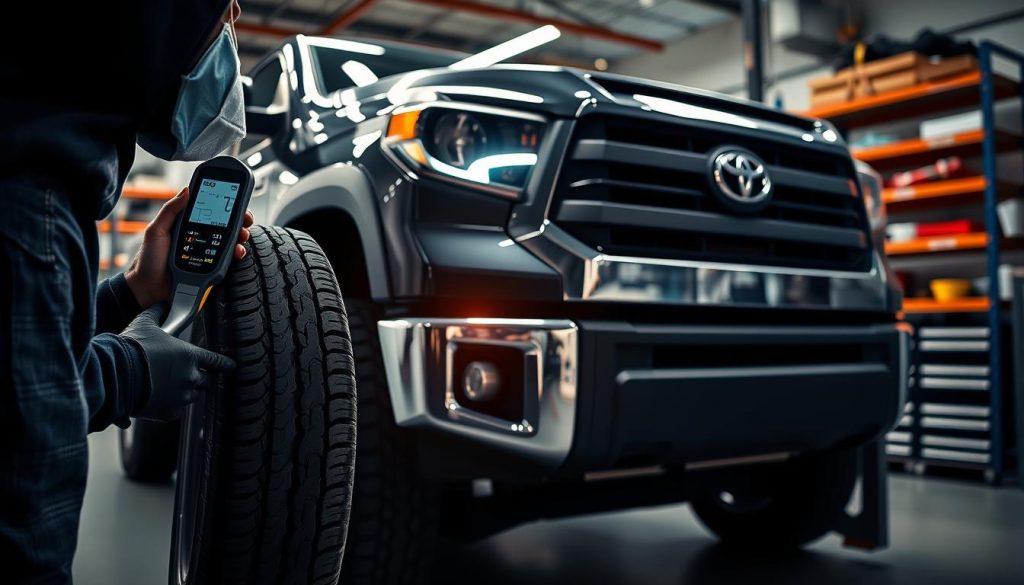
Start by checking your tire pressure and tread depth often. Good tire maintenance boosts traction and control, especially in bad weather. Make sure your brakes are in top condition too. During your routine safety checks, inspect and replace worn brake pads and rotors as needed.
Checking fluid levels is also crucial. Ensure your engine oil, coolant, brake fluid, and transmission fluid are all at proper levels for your vehicle to run smoothly. Frequent vehicle safety inspections should cover these elements to ensure top performance.
Regularly examine your lights and signals too. Functional headlights, taillights, and turn signals promote safety by enhancing visibility and communication. Make sure your Toyota Tundra’s battery is reliable, checking for corrosion and ensuring it’s fully charged.
Lastly, it’s essential to inspect safety belts, airbags, and other passive safety features periodically. These are critical in protecting you during accidents. Quickly fixing any detected problems ensures these systems function correctly when needed.
Adding these routine safety checks to your maintenance routine guarantees your Toyota Tundra remains safe and reliable. By having a professional mechanic regularly inspect these areas, you ensure your safety on every trip.
Driver Assistance Features in the Toyota Tundra
The Toyota Tundra comes with cutting-edge driver assistance features that enhance the driving experience and increase safety. These technologies provide drivers with peace of mind across different driving conditions. Let’s delve into three significant features: Parking Assist, Adaptive Cruise Control, and Lane Tracing Assist.
Parking Assist
The Toyota Tundra’s Parking Assist is a highly effective driver assistance feature. Utilizing sensors, it detects obstacles around the vehicle during parking. Drivers get visual and auditory signals to safely navigate tight spots, reducing collision or scratch risks. Hence, parking becomes effortless and more secure, safeguarding both the vehicle and its passengers.
Adaptive Cruise Control
Adaptive Cruise Control is a standout in the Toyota Tundra’s safety offerings. It dynamically adjusts speed to maintain a safe distance from the vehicle ahead. By leveraging radar and cameras, it monitors traffic conditions, ensuring a smoother and safer ride, especially on highways.
Lane Tracing Assist
Lane Tracing Assist is vital in the Toyota Tundra’s array of driver assistance technologies. It keeps the vehicle centered in its lane, an asset for long highway journeys. Cameras monitor lane markings and provide necessary steering corrections, minimizing the chance of unintentional lane departures. This system improves driving stability significantly.
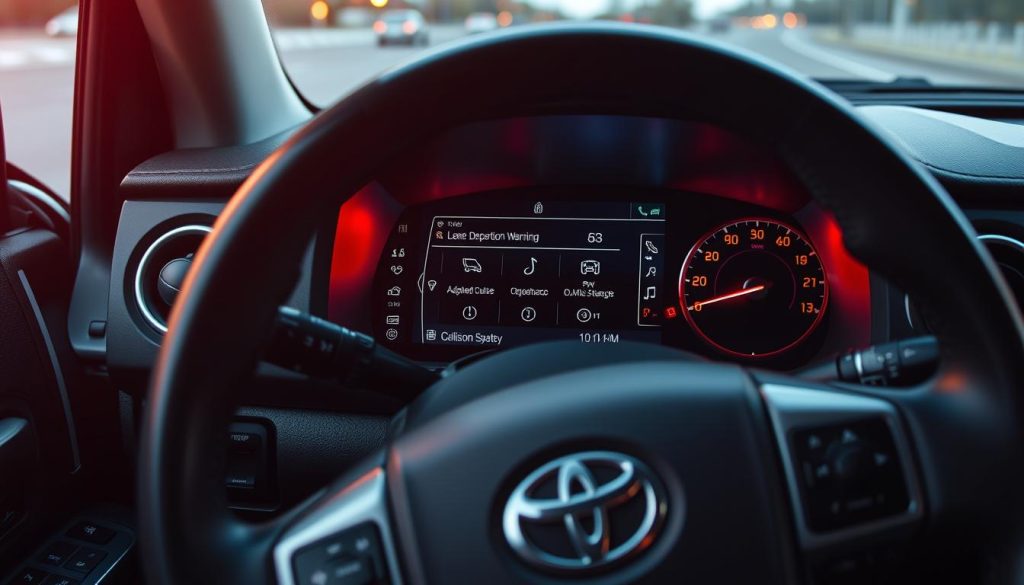
| Feature | Function | Benefit |
|---|---|---|
| Parking Assist | Sensors detect obstacles and provide alerts | Simplifies parking, reducing collision risk |
| Adaptive Cruise Control | Maintains set distance from the car ahead | Ensures smoother, safer highway driving |
| Lane Tracing Assist | Keeps the vehicle centered in its lane | Enhances driving stability and safety |
Understanding the Structure and Design for Optimal Safety
The Toyota Tundra is noteworthy for its focus on *vehicle design safety*. Its frame is made of high-strength steel, which adds robustness. This material choice is crucial for managing impact forces, thus lessening injury risks during crashes.
The Tundra’s design also features crumple zones at the front and rear. These zones absorb and dissipate crash energy. This critical design aspect demonstrates Toyota’s dedication to *vehicle design safety*.
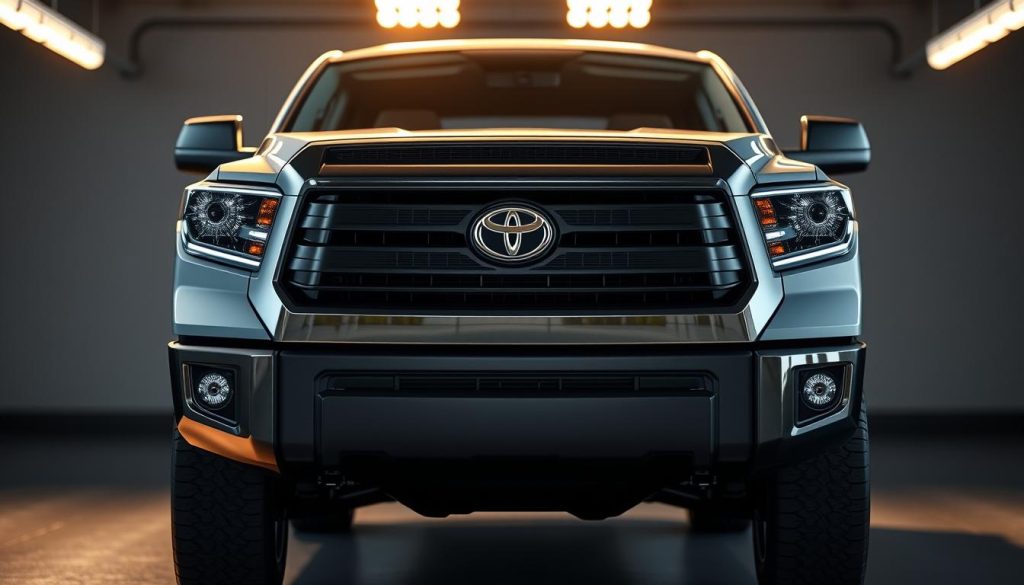
The cabin’s structure is reinforced with dual-layer impact beams in the doors. These beams increase *structural integrity*, protecting passengers against side impacts. The truck’s advanced airbag systems then provide additional protection in essential areas.
Another key to the Tundra’s *vehicle design safety* is component placement to ensure balance and stability. This design philosophy minimizes the risk of rollovers, underscoring the focus on *structural integrity*. Drivers and passengers thus enjoy a safer journey in the Toyota Tundra.
Conclusion
This guide has meticulously covered Toyota Tundra’s safety, dissecting crash test ratings, maintenance importance, and safety tech advancements. Every element aims to strengthen your vehicle’s safety, ensuring a secure drive every time.
We’ve highlighted Toyota Tundra’s advanced safety features like the Pre-Collision System with Pedestrian Detection, Dynamic Radar Cruise Control, and Lane Departure Alert with Steering Assist. Utilizing these technologies can significantly diminish risks and enhance safety for everyone in the vehicle.
After analyzing IIHS and NHTSA ratings and comparing the Tundra to its rivals, it’s clear that the Toyota Tundra is dedicated to being a safety leader. Timely safety inspections, proactive actions, and keeping up with safety feature upgrades are essential for maintaining top-notch safety in your Toyota Tundra.
With this knowledge, you’re prepared to make well-informed choices for safe driving. Empowering your journeys with maximum safety in your Toyota Tundra is now within your reach.
FAQ
How can I maximize the safety rating of my Toyota Tundra?
To improve your Toyota Tundra’s safety rating, focus on regular maintenance and embrace advanced safety features. Ensure all systems are functioning well. Essential checks should include tire conditions, brakes, and fluid levels. Additionally, drive carefully and consider any extra safety gear to boost protection.
What do crash test ratings indicate about the Toyota Tundra’s safety capabilities?
Crash test ratings reveal how well a vehicle safeguards its passengers during accidents. Agencies like IIHS and NHTSA conduct these tests. They assess the vehicle’s structural strength and safety feature effectiveness in various crash situations.
Why is regular maintenance important for maintaining the Toyota Tundra’s safety features?
Proper maintenance ensures the safety systems and vehicle components are reliable. It’s vital to keep tires, brakes, and fluids in check. This guarantees peak vehicle performance and safety.
What are some key safety technologies in the Toyota Tundra?
The Tundra is equipped with cutting-edge safety features. These include the Pre-Collision System, Dynamic Radar Cruise Control, and Lane Departure Alert. They aim to prevent accidents and aid the driver.
What advancements in safety technology are available in the Toyota Tundra?
The Tundra boasts newer safety features like Automatic High Beams and Road Sign Assist. Also, the Blind Spot Monitor improves driver awareness, making driving safer by aiding in visibility and alerting to blind spots.
How should I interpret the Toyota Tundra IIHS safety rating?
The IIHS rating measures the Tundra’s crashworthiness and avoidance capabilities. A high rating means excellent crash test performance and effective safety features. This provides superior occupant protection.
What are the trends in Toyota Tundra safety ratings and reviews?
The Toyota Tundra’s safety ratings and reviews have been progressively improving. This showcases ongoing enhancements in safety features and technologies. Consumer opinions on the vehicle’s safety have become increasingly positive.
How can I enhance my Toyota Tundra’s NHTSA safety rating?
Boosting the NHTSA rating involves enhancing safety features, keeping up with new safety tech, and adhering to maintenance schedules. Consider installing aftermarket safety items for improved ratings.
What changes have occurred in the Toyota Tundra safety ratings in 2021?
In 2021, the Tundra saw upgrades in safety features and tech compared to past models. Such improvements often lead to better crash test outcomes and improved ratings from IIHS and NHTSA.
What proactive safety measures can I take as a Toyota Tundra owner?
Being proactive means adopting safe driving practices, keeping up with maintenance, and adding more safety gear. Focus on the road and avoid distractions to prevent accidents and ensure the safety of your vehicle.
How does the Toyota Tundra compare to its competitors in terms of safety ratings?
The Tundra holds up well against rivals in safety scores. It typically features advanced safety tech and strong structural integrity. This ensures reliable protection for those inside.
What tips are there for upgrading the safety features of my Toyota Tundra?
Enhance your Tundra’s safety by integrating advanced assistance systems, improving light visibility, and adding aftermarket safety devices like dash cams. Keeping vehicle software updated can further improve safety tech.
What routine safety checks should I perform to maximize my Toyota Tundra’s safety?
Conduct regular inspections on tires, brakes, and fluid levels. Check that all lights work and inspect battery and engine oil. These actions help uphold your vehicle’s safety standards.
What specific driver assistance features are available in the Toyota Tundra?
The Tundra offers Parking Assist, Adaptive Cruise Control, and Lane Tracing Assist. These features help with parking, maintaining safe distances, and lane alignment, enhancing safety and ease of driving.
How do the structure and design of the Toyota Tundra contribute to its safety?
Its design includes a robust steel frame, crumple zones, and side-impact beams. These components absorb crash forces, minimizing injury risks and boosting occupant safety.
